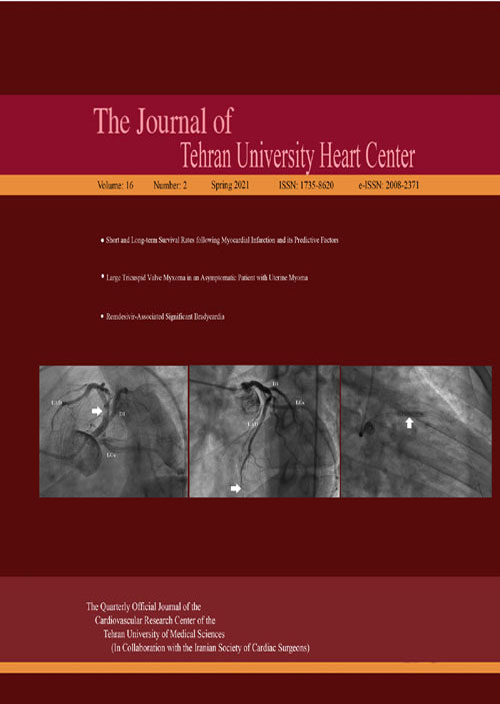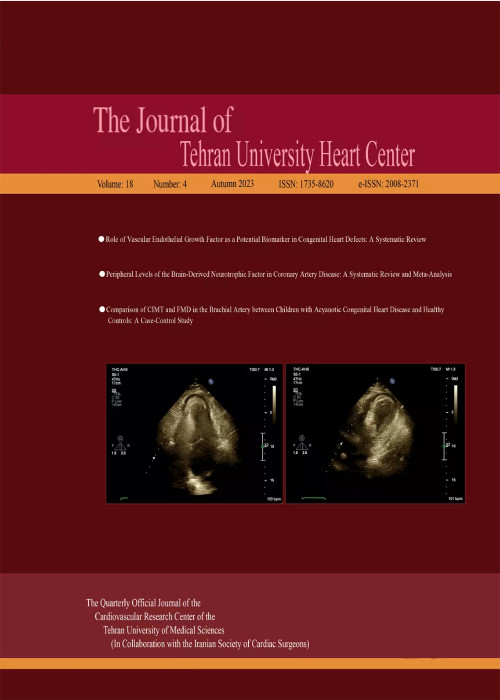فهرست مطالب

The Journal of Tehran University Heart Center
Volume:16 Issue: 4, Oct 2021
- تاریخ انتشار: 1400/11/24
- تعداد عناوین: 8
-
-
Pages 135-146Background
Tetralogy of Fallot (ToF) is a cardiac malformation that accounts for up to 1/10 of all congenital diseases. Although surgical repair serves as a treatment of choice, it cannot be performed unless weight and anatomical key factors are favorable. The stenting of the right ventricular outflow tract (RVOT) has become an alternative palliative procedure for ToF as an option to alleviate infundibular obstruction with minimal invasion.
MethodsA literature search was conducted through 7 databases, followed by the screening and independent assessment of 6 final studies, using the Newcastle-Ottawa Quality Assessment Scale (NOS). Analysis was then conducted using inverse variance analysis, and cumulative data were presented with forest and funnel plots.
ResultsStudied patients were referred for RVOT stenting due to the marked obstruction of the pulmonary blood flow, a low birth weight, or a small pulmonary artery size. The analysis revealed a significant increase in O2 saturation (mean difference [MD=18%; 13–23.78). The same trend was observed concerning an increase in the Nakata index (MD=54.59; 10.05–99.14), the right pulmonary artery diameter (MD=2.28; 1.20–3.36), and the left pulmonary artery diameter (MD=1.77; 0.22–3.32). Several complications were found, including tricuspid regurgitation and frequent premature beats.
ConclusionRVOT stenting is considered a feasible palliative treatment for ToF, with its high effectiveness in improving patients’ condition, especially their pulmonary flow. While complications are scarce, several conditions should be noted, particularly for fatal complications. Finally, this study has limitations as catheterization details in studies and diverse infants’ conditions may have caused potential bias.
Keywords: Tetralogy of Fallot, Palliative care, Safety, Postoperative complications, Ventricular outflow obstruction -
Pages 147-155Background
In patients with ST-segment-elevation myocardial infarction (STEMI), it is essential to determine the complexity of coronary lesions on presentation and predict the risk of no-reflow after primary percutaneous coronary intervention (pPCI). Given that inflammation plays an important role in the pathogenesis of atherosclerosis, using inflammatory indices might be helpful in this setting.
MethodsThis prospective cohort study recruited 200 consecutive patients with STEMI who underwent pPCI. The presentation neutrophil-to-lymphocyte-ratio (NLR) and the systemic inflammatory immunologic index (SII), calculated using the formula platelets × neutrophils/lymphocytes, were recorded. Study outcomes included the SYNTAX score and the TIMI flow grade before and after pPCI. The associations between the NLR and the SII and the study outcomes were investigated using univariate and multivariate logistic regression analyses.
ResultsAmong 200 patients at a mean age of 59.85±11.23 years, 160 (80.0%) were male and 40 (20.0%) were female. The NLR and SII values were not statistically different between the 3 SYNTAX subgroups. While the mean NLR and SII values were similar between the patients with preprocedural TIMI flow grades 0/1 and 2/3, the mean NLR and SII were significantly lower in the group with a postprocedural TIMI flow grade 3. After adjustments for age and sex, the NLR and the SII were independent predictors of postprocedural no-reflow.
ConclusionIn patients with STEMI, the presentation NLR and SII are useful for predicting the risk of no-reflow after pPCI. However, the NLR and the SII are not predictors of the SYNTAX score and the preprocedural TIMI flow grade.
Keywords: Myocardial infarction, No-reflow phenomenon, Coronary artery disease, Percutaneous coronary intervention, Neutrophils, Lymphocytes, Blood platelets -
Pages 156-161Background
Computed tomography pulmonary angiography (CTPA) as the gold-standard examination in the detection of pulmonary embolism (PE) is contraindicated or unavailable in certain cases. The current study aimed to assess the accuracy of unenhanced CT in the diagnosis of PE.
MethodsThis cohort study was conducted between October 2020 and March 2021 in Birjand, Iran, on 195 participants with clinical suspicion of PE examined with multidetector computed tomography (MDCT) scanning and CTPA. The patients were categorized into 2 groups based on the diagnosis PE in CTPA results. Imaging variables in unenhanced CT scans, including hyper/hypodense intraluminal signs, pulmonary trunk enlargements, peripheral wedge-shaped opacities, and pleural effusions, were independently reviewed by 2 radiologists and then compared between the groups.
ResultsThere were 82 men (42.1%) and 113 women (57.9%) at a mean age ± standard deviation of 56.00±0.24 years. Based on CTPA results, PE was diagnosed in 24.1% of the study population (47/195). However, only 20 cases (42.5%) were detected by MDCT: 17 cases (85.0%) with central PE and 3 cases (15.0%) with peripheral PE. Concerning the intraluminal clot density, 12 patients (60.0%) had hyperdense signs, 3 (15.0%) had hypodense signs, and 5 (25.0%) had mixed hyper/hypodense signs. There was a significant difference between central PE and peripheral PE detected by MDCT. Intraluminal signs had the highest specificity and sensitivity (98.6% and 42.5%, area under the curve =0.734).
ConclusionUnenhanced MDCT has a remarkable performance in detecting PE, specifically central clots, and can, therefore, be considered an alternative modality when CTPA is not available or indicated.
Keywords: Pulmonary embolism, Multidetector computed tomography, Contrast media, Computed tomography angiography, Sensitivity, specificity -
Pages 162-168Background
The prevalence of metabolic syndrome (MetSyn) is increasing in Iran. This study was an attempt to determine the effects of a short message service (SMS)-based education intervention on knowledge, attitudes, and the adoption of preventive behaviors concerning MetSyn among a sample of employees of Iran University of Medical Sciences (IUMS).
MethodsIn this randomized controlled trial, conducted from January through April 2021, IUMS 144 were assigned either to the intervention group (n=72) or to the control group (n=72). Thirty-two text messages were designed, pretested, and sent to the participants’ phones in the intervention group in 32 days. Knowledge, attitudes, and the adoption of preventive behaviors vis-à-vis MetSyn were measured in the intervention group before and 1 month after the intervention and compared with those in the control group at the same time points. The data were analyzed using paired t tests and ANCOVA.
ResultsThe mean age of the employees in the intervention and control groups was 42.97±8.80 and 40.81±9.58 years, respectively. The results showed that the mean scores of knowledge (P<0.001), attitudes (P<0.001), and the adoption of preventive behaviors regarding MetSyn (P=0.009) were significantly different between the intervention and control groups after the intervention was done via SMS.
ConclusionsThe results of the present study showed that SMS-based interventions might improve knowledge, attitude, and the adoption of preventive behaviors pertaining to MetSyn among employees.
Keywords: Metabolic syndrome, Knowledge, Attitude, Behavior, Text messaging -
Pages 169-173
Percutaneous coronary intervention (PCI) is increasingly employed in the treatment of complex coronary artery disease. The entrapment or fracture of a coronary angioplasty guidewire is a rare complication of PCI. We herein describe a 61-year-old man who presented with chronic stable angina. The patient’s coronary angiogram revealed triple-vessel coronary artery disease, and he was scheduled for primary PCI. During the procedure, the guidewire fractured within the right coronary artery. Despite multiple attempts, the wire could not be retrieved. The wire unraveled in its coils, and its stretching resulted in its eventual snapping in the right radial artery. The initial plan was to attempt guidewire retrieval through a brachial cut-down, and if successful, to manage the obtuse marginal lesion by PCI, thereby precluding general anesthesia and a sternotomy. Unfortunately, the guidewire snapped at the brachial level, necessitating its retrieval by coronary artery bypass surgery. The patient remained asymptomatic and event-free over 6 months of follow-up.
Keywords: Coronary artery disease, Percutaneous coronary intervention, Catheterization, Foreign bodies, Coronaryartery bypass -
Pages 174-177
Myxomas are rare cardiac neoplasms and may present as single or multiple tumors. Only a few cases of single biatrial myxomas have been reported. We report a very rare case of this condition in a middle-aged woman, presenting with exertional dyspnea and cough. The patient had a resting tachycardia of 105 beats per minute, and cardiac auscultation discovered a mid-diastolic murmur across the mitral valve, followed by a tumor plop focused on the apex and elevated levels of C-reactive protein (1+) and creatine phosphokinase in lab data. The diagnosis was made via transesophageal and transthoracic echocardiographic examinations, showing the tumor extension through a patent foramen ovale (PFO). The operation was undertaken, the myxoma was excised, and the PFO was repaired. She was discharged with no further complications. Although myxomas are rare, considering this condition before surgery is significant. The involvement of both atria via a PFO is possible.
Keywords: Myxoma, Cardiac neoplasm, Foramen ovale, patent -
Pages 178-181
Intravenous leiomyomatosis (IVL) is a rare and benign smooth muscle tumor that arises from intrauterine venules or the myometrium. We herein describe a 49-year-old woman with a history of myomectomy who developed abdominal pain. An intravascular mass with extension to the right atrium was detected in the inferior vena cava. The mass was surgically resected in a single stage under cardiopulmonary bypass. IVL features were indicated by subsequent histopathology. Postoperatively, the patient was diagnosed with massive pericardial effusion and treated with a pericardial window. At 3 months’ outpatient clinical follow-up, she was asymptomatic. This case indicates that the diagnosis of IVL with extension to the heart should be kept in mind in patients presenting with abdominal pain.
Keywords: Leiomyomatosis, Cardiac tumor, Adult


